ASRock FM2A85X Extreme6 Review
by Ian Cutress on December 3, 2012 12:00 PM EST- Posted in
- Motherboards
- AMD
- ASRock
- Trinity
- FM2
3D Movement Algorithm Test
The algorithms in 3DPM employ both uniform random number generation or normal distribution random number generation, and vary in various amounts of trigonometric operations, conditional statements, generation and rejection, fused operations, etc. The benchmark runs through six algorithms for a specified number of particles and steps, and calculates the speed of each algorithm, then sums them all for a final score. This is an example of a real world situation that a computational scientist may find themselves in, rather than a pure synthetic benchmark. The benchmark is also parallel between particles simulated, and we test the single thread performance as well as the multi-threaded performance.
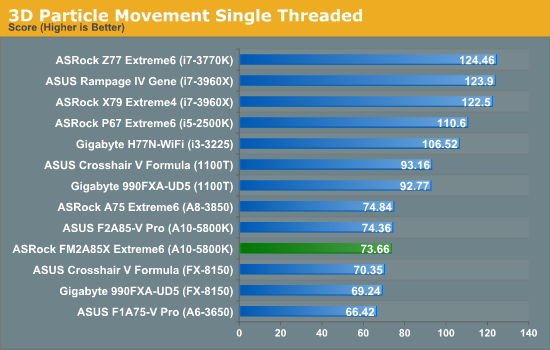
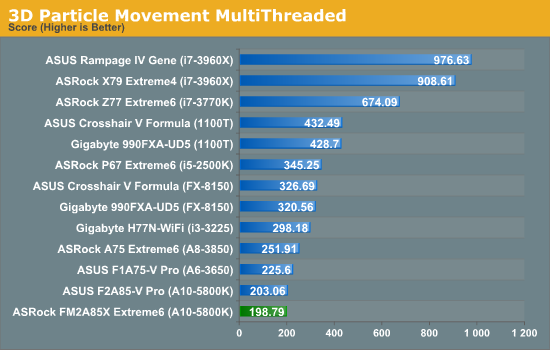
With the advent of the CPU manufacturers taking different directions (AMD prioritizing INT over FP ops), and motherboard manufacturers playing around with default speeds via MultiCore Enhancement/Acceleration, pure real-life performance benchmarks can offer a wide array of results. The main competitor to the A10-5800K is the i3-3225, to which they each take blows, but the Intel chip excels in single thread performance. In terms of the FM2A85X Extreme6, our only reference point is the F2A85-V Pro, which takes the lead in our 3DPM testing.
WinRAR x64 3.93 - link
With 64-bit WinRAR, we compress the set of files used in the USB speed tests. WinRAR x64 3.93 attempts to use multithreading when possible, and provides as a good test for when a system has variable threaded load. If a system has multiple speeds to invoke at different loading, the switching between those speeds will determine how well the system will do.
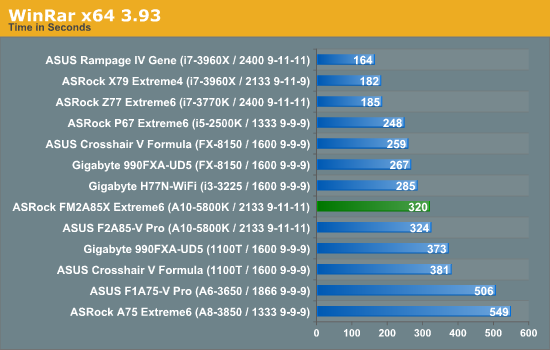
Given that WinRAR is quite variable to memory speed, and our memory speed testing has changed over the years depending on chipset and CPU capabilities, we have included our various results in this graph for comparison. The ASUS and ASRock FM2 boards are found between 320-324 seconds for this test, but do get trumped by the i3-3225 result despite the advantage in memory speed.
FastStone Image Viewer 4.2 - link
FastStone Image Viewer is a free piece of software I have been using for quite a few years now. It allows quick viewing of flat images, as well as resizing, changing color depth, adding simple text or simple filters. It also has a bulk image conversion tool, which we use here. The software currently operates only in single-thread mode, which should change in later versions of the software. For this test, we convert a series of 170 files, of various resolutions, dimensions and types (of a total size of 163MB), all to the .gif format of 640x480 dimensions.
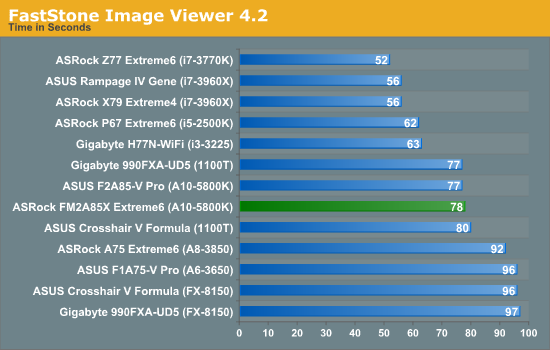
The single-threaded nature of our FastStone benchmark means that the AMD boards were more than likely to trail behind. However comparing the ASRock to our other FM2 board tested shows a small difference between the two.
Xilisoft Video Converter
With XVC, users can convert any type of normal video to any compatible format for smartphones, tablets and other devices. By default, it uses all available threads on the system, and in the presence of appropriate graphics cards, can utilize CUDA for NVIDIA GPUs as well as AMD APP for AMD GPUs. For this test, we use a set of 32 HD videos, each lasting 30 seconds, and convert them from 1080p to an iPod H.264 video format using just the CPU. The time taken to convert these videos gives us our result.
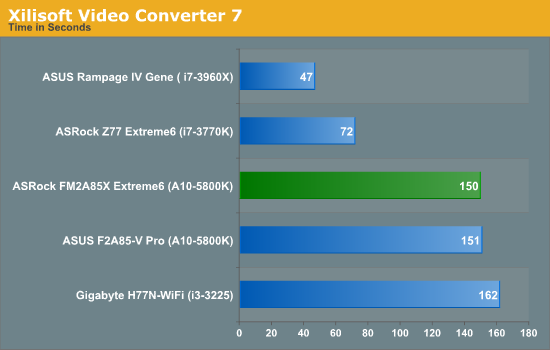
Modern video conversion is a highly optimized and highly parallel process. Anything that can take advantage of more cores, more cache and more threads is going to perform well. This means that Trinity takes over from the i3-3225 by a good margin, and the ASRock FM2 board is favorably competitive against the other FM2 boards.
x264 HD Benchmark
The x264 HD Benchmark uses a common HD encoding tool to process an HD MPEG2 source at 1280x720 at 3963 Kbps. This test represents a standardized result which can be compared across other reviews, and is dependant on both CPU power and memory speed. The benchmark performs a 2-pass encode, and the results shown are the average of each pass performed four times.
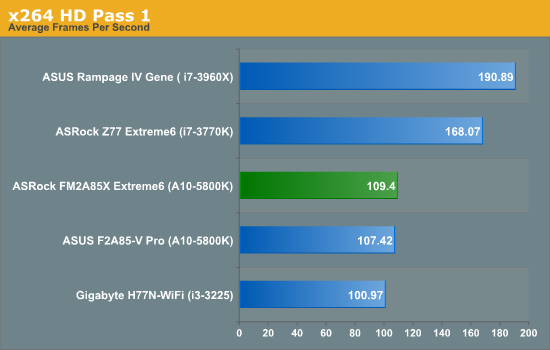
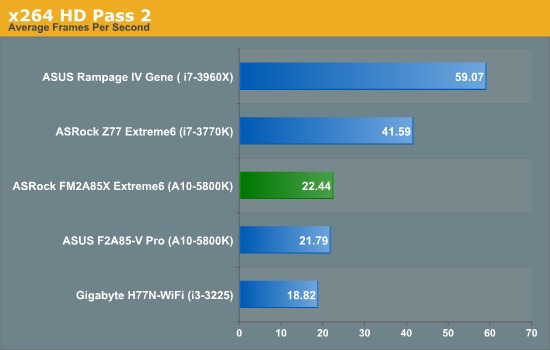
Similarly to our XVC test, video conversion seems to be the key to these Trinity processors. The ASRock FM2 performs above the ASUS FM2 in our test.










19 Comments
View All Comments
ivica - Monday, December 3, 2012 - link
is there for another reason. There are 3 options to set fast boot on ASrock motherboards, and fastest one disables "entering bios"... so, you can't access bios unless you clear CMOS or through that specific option in AXTU.DanNeely - Monday, December 3, 2012 - link
This seems like an odd feature for a midrange board as opposed to one targeted at the sub-ambient cooling crowd.That aside, I'm curious how it works. Does it just periodically spin the fans up long enough to cycle the air in the case; or is their a humidity sensor that detects when it needs to be cycled.
automaticgiant - Monday, December 3, 2012 - link
I looked at the Realtek website and the feature list for each chip but was unable to determine why one is better other than the power saving. It sounds like "The ASUS gives us another USB 3.0 controller, the ALC892 audio codec and the 8111F NIC - in turn, the ASRock board gives an ASMedia USB 3.0 controller, the better ALC898 audio codec but the 8111E NIC" is saying that the E is crap, but I might be reading into it too much.Merlyn2220 - Monday, December 3, 2012 - link
"Firstly, the amount of components on the top left of the motherboard is insane." This and the following statements are completely wrong. The extra components are likely tuned values of capacitors, resistors and ferrite beads intended to soften clock edges (reducing EMI) and improve high speed stability. As an engineer handling moderate-speed (sub-1GHz) clocks I can say with authority that these components are likely critical to the board's stability and performance. To say that having fewer components helps overclocking is pretty ignorant. /end rant.Rajinder Gill - Tuesday, December 4, 2012 - link
Most of those will be VRM related components. The amount of decoupling that needs to be used depends on the circuit. Generally, better VRM controllers and FETs need fewer output capacitors. The amount of surrounding circuitry for pulling legs of the buck controller down or up varies also - some buck controllers don't need a lot of external hardware to function.cosmotic - Monday, December 3, 2012 - link
In that last product shot, is that on glass or what?Wardrop - Tuesday, December 4, 2012 - link
No. It's the official ASRock product shot. You can tell it's two images layered one on top of the other. They've just added a very rough reflection and shadow effect in Photoshop.abianand - Tuesday, December 4, 2012 - link
What is AMD A10-4800K?- Power Consumption and Post Times page
cyrusfox - Tuesday, December 4, 2012 - link
Well it is obvious he meant the 5800k from the other pages but yes that is a typo in that table there.Garestle - Thursday, March 26, 2020 - link
Check this <a href="http://www.google.com/">google</a> and get everything you need.